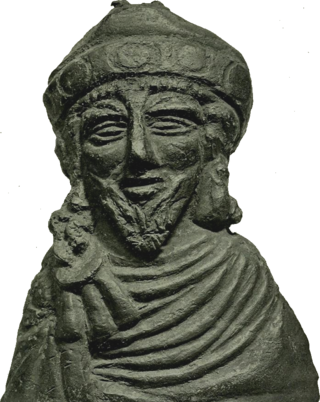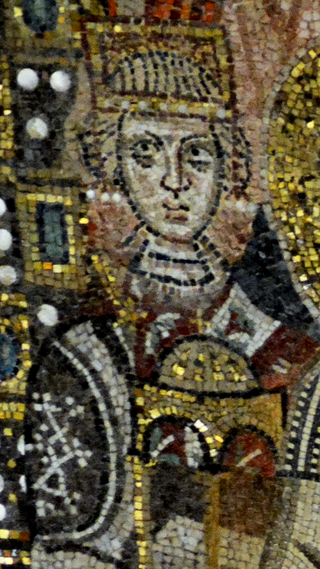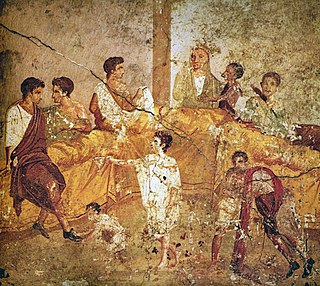Related Research Articles
A poll tax, also known as head tax or capitation, is a tax levied as a fixed sum on every liable individual, without reference to income or resources. Poll is an archaic term for "head" or "top of the head". The sense of "counting heads" is found in phrases like polling place and opinion poll.

Phocas was Eastern Roman emperor from 602 to 610. Initially, a middle-ranking officer in the Eastern Roman army, Phocas rose to prominence as a spokesman for dissatisfied soldiers in their disputes with the court of the Emperor Maurice. When the army revolted in 602, Phocas emerged as the natural leader of the mutiny. The revolt proved to be successful and led to the capture of Constantinople and the overthrow of Maurice on 23 November 602 with Phocas declaring himself emperor on the same day.

Justinian II, nicknamed "the Slit-Nosed", was the last Byzantine emperor of the Heraclian dynasty, reigning from 685 to 695 and again from 705 to 711. Like his namesake, Justinian I, Justinian II was an ambitious and passionate ruler who was keen to restore the Roman Empire to its former glories. However, he responded brutally to any opposition to his will and lacked the finesse of his father, Constantine IV. Consequently, he generated enormous opposition to his reign, resulting in his deposition in 695 in a popular uprising. He only returned to the throne in 705 with the help of a Bulgar and Slav army. His second reign was even more despotic than the first, and it too saw his eventual overthrow in 711. He was abandoned by his army, who turned on him before killing him.

Gaius Messius Quintus Traianus Decius, sometimes translated as Trajan Decius or Decius, was the emperor of the Roman Empire from 249 to 251.

The Roman emperor was the ruler and monarchial head of state of the Roman Empire during the imperial period. The emperors used a variety of different titles throughout history. Often when a given Roman is described as becoming "emperor" in English it reflects his taking of the title augustus. Another title often used was caesar, used for heirs-apparent, and imperator, originally a military honorific. Early emperors also used the title princeps civitatis. Emperors frequently amassed republican titles, notably princeps senatus, consul, and pontifex maximus.

Egypt was a subdivision of the Roman Empire from Rome's invasion of the Ptolemaic Egyptian Kingdom after the battle of Alexandria in 30 BC to its loss by the Byzantine Empire to the Islamic conquests in AD 641. The province encompassed most of modern-day Egypt except for the Sinai, and was bordered by the provinces of Crete and Cyrenaica to the west and Judea, later Arabia Petraea, to the East. Egypt came to serve as a major producer of grain for the empire and had a highly developed urban economy. Aegyptus was by far the wealthiest Eastern Roman province, and by far the wealthiest Roman province outside of Italy. The population of Roman Egypt is unknown, although estimates vary from 4 to 8 million. Alexandria, its capital, was the largest port and second largest city of the Roman Empire.

The Byzantine senate or eastern Roman senate was a continuation of the Roman Senate, established in the 4th century by Constantine I. It survived for centuries, but the senate's powers varied greatly during its history and gradually diminished until its eventual disappearance circa 14th century.
A Roman military diploma was a document inscribed in bronze certifying that the holder was honourably discharged from the Roman armed forces and/or had received the grant of Roman citizenship from the emperor as reward for service.

The fiscus Iudaicus or Judaicus was a tax imposed on Jews in the Roman Empire after the destruction of Jerusalem and its Temple in AD 70. Revenues were directed to the Temple of Jupiter Optimus Maximus in Rome.

In the early Roman Empire, from 30 BC to AD 212, a peregrinus was a free provincial subject of the Empire who was not a Roman citizen. Peregrini constituted the vast majority of the Empire's inhabitants in the 1st and 2nd centuries AD. In AD 212, all free inhabitants of the Empire were granted citizenship by the Constitutio Antoniniana, with the exception of the dediticii, people who had become subject to Rome through surrender in war, and freed slaves.

Vitale II Michiel was Doge of Venice from 1156 to 1172.

The Byzantine Empire, also referred to as the Eastern Roman Empire or Byzantium, was the continuation of the Roman Empire primarily in its eastern provinces during Late Antiquity and the Middle Ages, when its capital city was Constantinople. It survived the fragmentation and fall of the Western Roman Empire in the 5th century AD and continued to exist for an additional thousand years until the fall of Constantinople to the Ottoman Empire in 1453. During most of its existence, the empire remained the most powerful economic, cultural, and military force in Europe. The terms "Byzantine Empire" and "Eastern Roman Empire" were coined after the end of the realm; its citizens continued to refer to their empire as the Roman Empire, and to themselves as Romans—a term which Greeks continued to use for themselves into Ottoman times. Although the Roman state continued and its traditions were maintained, modern historians prefer to differentiate the Byzantine Empire from Ancient Rome as it was centred on Constantinople instead of Rome, oriented towards Greek rather than Latin culture, and characterised by Eastern Orthodox Christianity.
Procurator was a title of certain officials in ancient Rome who were in charge of the financial affairs of a province, or imperial governor of a minor province.

This history of the Byzantine Empire covers the history of the Eastern Roman Empire from late antiquity until the Fall of Constantinople in 1453 AD. Several events from the 4th to 6th centuries mark the transitional period during which the Roman Empire's east and west divided. In 285, the emperor Diocletian partitioned the Roman Empire's administration into eastern and western halves. Between 324 and 330, Constantine I transferred the main capital from Rome to Byzantium, later known as Constantinople and Nova Roma. Under Theodosius I, Christianity became the Empire's official state religion and others such as Roman polytheism were proscribed. And finally, under the reign of Heraclius, the Empire's military and administration were restructured and adopted Greek for official use instead of Latin. Thus, although it continued the Roman state and maintained Roman state traditions, modern historians distinguish Byzantium from ancient Rome insofar as it was oriented towards Greek rather than Latin culture, and characterised by Orthodox Christianity rather than Roman polytheism.

The history of the Jews in the Roman Empire traces the interaction of Jews and Romans during the period of the Roman Empire. A Jewish diaspora had migrated to Rome and to the territories of Roman Europe from the land of Israel, Anatolia, Babylon and Alexandria in response to economic hardship and incessant warfare over the land of Israel between the Ptolemaic and Seleucid empires from the 4th to the 1st centuries BCE. In Rome, Jewish communities thrived economically. Jews became a significant part of the Roman Empire's population in the first century CE, with some estimates as high as 7 million people; however, this estimation has been questioned.

The Romans were a cultural group, variously referred to as an ethnicity or a nationality, that in classical antiquity, from the 2nd century BC to the 5th century AD, came to rule large parts of Europe, the Near East and North Africa through conquests made during the Roman Republic and the later Roman Empire. Originally only referring to the Italic Latin citizens of Rome itself, the meaning of "Roman" underwent considerable changes throughout the long history of Roman civilisation as the borders of the Roman state expanded and contracted. At times, different groups within Roman society also had different ideas as to what it meant to be Roman. Aspects such as geography, language, and ethnicity could be seen as important by some, whereas others saw Roman citizenship and culture or behaviour as more important. At the height of the Roman Empire, Roman identity was a collective geopolitical identity, extended to nearly all subjects of the Roman emperors and encompassing vast regional and ethnic diversity.
In Ancient Rome, Tributum was a tax imposed on the citizenry to fund the costs of war. The Tributum was one of the central reasons for the conducting of the census on assets, as it rose with wealth. It included cash assets, land, property and moveable goods. Several types of tributum have been attested to, including tributum in capita, tributum temerarium, and tributum ex censu.

The problem of two emperors or two-emperors problem is the historiographical term for the historical contradiction between the idea of the universal empire, that there was only ever one true emperor at any one given time, and the truth that there were often multiple individuals who claimed the position simultaneously. The term is primarily used in regards to medieval European history and often refers to in particular the long-lasting dispute between the Byzantine emperors in Constantinople and the Holy Roman emperors in modern-day Germany and Austria as to which monarch represented the legitimate Roman emperor.
There were four primary kinds of taxation in ancient Rome: a cattle tax, a land tax, customs, and a tax on the profits of any profession. These taxes were typically collected by local aristocrats. The Roman state would set a fixed amount of money each region needed to provide in taxes, and the local officials would decide who paid the taxes and how much they paid. Once collected the taxes would be used to fund the military, create public works, establish trade networks, stimulate the economy, and to fund the cursus publicum.
References
- ↑ Digest 50, tit.15